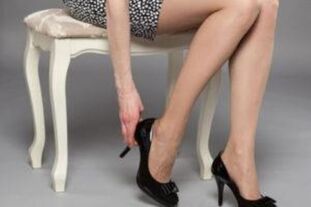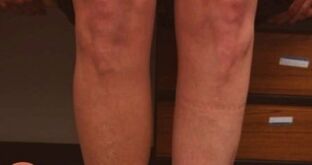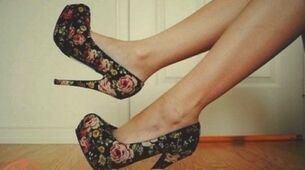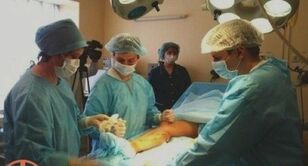Varicose veins are a common pathological process accompanied by the appearance of varicose veins, nodules and blood stasis. Internal varicose veins in the legs are characterized by the nodular structure of venous vessels in the epidermis. There are no symptoms in the early stages of the disease. Many people have a question about what is the treatment for this disease.
What is this?

Varicose veins of the lower extremities are a very dangerous disease that can be fatal. This is a pathological lesion of the circulatory system. With the progression of the disease, the process of elongation and elongation of the vessels is observed.
Nodules begin to form in the capillaries, which impede normal blood flow. With varicose veins of the deep veins, the walls of the veins dilate so much that the function of the valves deteriorates. Therefore, the blood begins to stagnate in the legs.The disease mainly affects people between the ages of 30 and 40.
developmental reasons
The causes of this disease can be very different. Among them:
- hereditary factors (possible congenital anomaly or weakness of venous cells);
- is more common in women (the disease is more common in women due to the use of hormonal drugs, the risk increases due to delayed delivery);
- increased pressure inside the arteries (this is due to a sedentary lifestyle in the presence of excess weight);
- presence of neuroendocrine changes; mechanical obstructions to normal blood circulation (this can be facilitated by constant compression of the limbs);
- presence of allergic reactions;
- changes in the immune system;
- disorders of the venous system;
- This pathology can begin to develop due to cellulite or dermatitis.
It is important to determine the root cause of the disease before starting treatment. An experienced phlebologist will help you to do this.
Symptoms and manifestations of internal varicose veins
If varicose veins appear in the lower extremities, it is important to see a doctor in time. In the early stages of varicose veins, the symptoms of this disease will be as follows:

- by the end of the day there is swelling of the extremities(this symptom is seen in the ankles and feet, edema can also be seen in the lower half of the lower leg);
- The patient has a feeling of heaviness in the calf muscles(a feeling of satiety occurs after a long walk or standing, this symptom may occur after prolonged sitting).
This is a characteristic feature of this diseaseAfter rest, all symptoms disappear without a trace. It shrinks even after a long rest.
During the gradual development of varicose veins, the following symptoms will begin to appear:
- calf muscles begin to show moderate pain, such pain becomes dull and painful;
- local burning sensation and fatigue;
- Excessive dryness of the skin is visible, pigment spots and skin induration begin to appear;
- very frequent cramps at night;
- spider veins begin to appear on the epidermis;
- photos The internal veins in the legs, presented below, begin to dilate significantly, resembling clusters of grapes;
- It is possible to create delicate wounds that heal for a long time.
Important!Timely treatment of this disease for the patient can lead to a number of complications. In some cases, a fatal outcome is possible.

After a while, eczema and trophic ulcers begin to appear. Such symptoms easily turn into gangrene. All this can lead to amputation, sepsis or death.
The most dangerous result is the formation of a blood clot with subsequent separation. This is the death of the patient.
Symptoms and treatment of occult varicose veins are the most important question for patients.
Treatment methods
Varicose veins are treated conservatively and operatively. Treatment of internal vessels in the legs, which may manifest symptoms differently, is carried out only after the initial diagnosis.The following methods can be used:
- compression;
- scleropathy;
- medicine;
- surgical.
Compression MethodsTreatment helps to cope with the early stages of the disease. This method of therapy involves the wearing of special compression underwear on a daily basis.
Vascular occlusion during scleropathy. The reason for this is the inclusion of sclerotherapy preparations. After such actions, blood can easily pass through the capillaries.
Conservative treatment is effective only at the first signs of the disease. Medications venotonics are prescribed to patients. They help strengthen the walls of blood vessels as much as possible.
Self-medication of internal varicose veins, the symptoms of which can be both mild and vice versa, is prohibited.
Prevention
In order to prevent the occurrence of varicose processes, it is important to know the root causes of this disease and prevent its development. Precautions include:
- requires regular physical activity (people who lead a sedentary lifestyle are very susceptible to the disease. Take breaks from time to time, get up and exercise to keep the blood circulating);
- It is forbidden to cross your legs while sitting;
- Get rid of all bad habits;
- Pay attention to your diet, avoid too much fat and salt;
- Taking therapeutic measures in connection with endocrine diseases leads to the development of varicose veins;
- use only loose, non-tight shoes (you need to ensure free blood circulation, as well as limit yourself in high-heeled shoes);
- Take sea baths, but at the same time avoid overheating of the sun.
Result
It should be noted that if at least one of the symptoms of this disease manifests itself, it is necessary to immediately consult a specialist. The doctor will prescribe diagnostic procedures and prescribe appropriate treatment. Delay threatens complications.
From the above, we can conclude that varicose veins are a very dangerous disease that can lead to undesirable consequences. Therefore, it is necessary to seek the help of a doctor when at least one symptom appears. Only a specialist can choose the right treatment.
Internal varicose veins in the legs: symptoms and treatment
The geography of varicose veins covers almost all countries of the world, is one of the oldest diseases known to mankind. According to medical statistics, varicose veins of the lower extremities and pelvic organs occur in 15-17% of the population. Today, patients with this diagnosis make up about 4% of all patients in surgical clinics. According to scientists, this disease is a kind of payment for the ability to walk upright. Let's look at what are internal varicose veins, the main symptoms of the disease and effective treatment.
An explanation of the appearance of the disease
The development of internal varicose veins in the legs is one of the most dangerous types of the disease, which manifests itself in the pathological dilation of blood vessels located deep in the skin in the tissues.
Unfortunately, this disease often affects young people of working age, and the symptoms are more common in women. The internal varicose veins in the legs are often accompanied by external ones in the form of light blue strongly protruding round veins.
These symptoms of varicose veins make treatment difficult. The appearance of legs with varicose veins is presented in numerous photos from medical sites.
Dilation of venous vessels in the legs can be an independent pathology, but in most cases it is caused by other diseases, and therefore in modern medicine it is customary to divide varicose veins into primary and secondary. The cause of primary varicose veins of the deep veins of the legs is the weakness of the venous wall or its functional pathologies, which also lead to varicose veins of the pelvic organs. Among the main causes of the disease:
- Pregnancy.
- Overweight, obese.
- Prolonged load on the lower extremities is associated with continuous work on the legs or constant heavy lifting.
- Hereditary or congenital weakness of the connective tissue of various organs.
- Walk in long heels and wear socks with tight elastic bands.
- Hormonal changes in the body can cause the formation of internal varicose veins in elderly patients.

The development of secondary internal varicose veins is the result of changes in the process of venous bleeding in various diseases:
- Post-thrombophlebic syndrome.
- Deep vascular valve insufficiency.
- Tumors of organs of various etiologies.
- Injuries to limbs and other organs.
Treatment of primary and secondary varicose veins is different.
Key Features
The consequences of internal varicose veins that are not detected in time can be very serious, so it is necessary to pay attention to the first signs of the disease, especially in comparison with other forms of the disease, which manifests itself very clearly in vision. The main symptoms of internal varicose veins of the lower extremities are as follows:
- The pain in the calf muscles is so severe that it is often unbearable that the patient is forced to take intense pain medication on a regular basis. These symptoms are the cause of emergency medical care.
- The venous pattern in the lower extremities in the thigh area is manifested, the veins are strongly convex and round, easily identified by palpation.
- Venous pattern takes on a cyanotic color, sometimes black, sometimes purple-red.
- The lower extremities are very swollen and the swelling does not decrease after a night's sleep.
- In the evening, after a day of work on the leg, the patient often has cramps in the calf muscles.
All these symptoms significantly worsen the patient's quality of life and require urgent medical intervention, sometimes only vascular treatment.

Clinical presentation
The severity of the symptoms of internal varicose veins depends on the stage of the disease.
At the initial stage, no pathological changes are found in the walls of blood vessels, patients have swelling in the legs and heaviness in the legs at the end of the working day, but after a night's rest, these unpleasant feelings disappear.
Some patients have a slight tenderness, this stage of the disease is called "intradermal varicose veins". If treatment is started at this stage of the disease, the prognosis is very favorable, because the vascular valve system has not yet been changed and can cope with the load, the pathological symptoms will disappear quickly.
In the second stage of the disease, edema of the lower extremities is persistent, patients complain of a constant increase in weight and fatigue in the legs. At this stage of the disease, the manifestations of internal varicose veins are also manifested by constant cramps of the calf muscles and cold limbs.
A photograph in a medical publication shows that blood vessels have begun to appear on the skin on the inside of the thigh, but the visible areas are not painful on palpation. At this stage, varicose veins begin to form, which can cause bleeding.
These symptoms worsen very quickly and if left untreated, the disease progresses to the next stage.
The third stage of varicose veins of the legs is well defined visually, which can be seen in the photo from various medical sources.
Varicose veins and sacral dilatations caused by severe circulatory disorders are already well defined under the skin in the calves and inner thighs.
At this stage, the patient has the appearance of nodules, fragility and hair loss, dry skin, persistent cramps in the calf muscles.
The fourth stage of the disease is accompanied by serious complications (bleeding, ulcers, etc. ) that can already be fatal. You should start treatment immediately without waiting for the huge symptoms.
Complications
These include:
Trophic ulcers on the skin of the legs.
This is a very painful complication for the patient, as trophic ulcers heal very slowly and patients experience persistent itching and burning in the area where they are located.
The photo clearly shows that the ulcers are round, brightly colored and have different types of secretions: purulent, hemorrhagic or serous discharge. They appear in calves and inside the thighs.
With competent and timely therapy, scarring begins in ulcers, but if there is no help or quality care, the patient may develop gangrene and then amputation of the joint. Death is also possible.
Traumatic bleeding.
Massive bleeding can be caused by a thinning of the venous wall due to a constantly rising blood pressure or a rupture of a blood vessel due to minor trauma. This syndrome is especially dangerous because bleeding can lead to the death of the patient.
Thrombosis is a result of blockage and inflammation in the arteries of the lower extremities. Thrombosis can only manifest itself visually with swelling of the foot and severe pain inside.
With the formation of external venous nodules, thrombosis is accompanied by severe pain in the area of thrombus formation, vascular sensitivity on palpation and fever in the area of thrombosis.
Thrombosis is very dangerous for the patient's life and requires urgent hospitalization and treatment, as it can cause a heart attack and pulmonary artery occlusion in the patient.

Basics of Therapy
Varicose veins in the legs are very difficult to treat, and the effectiveness of therapy depends largely on the stage of the disease.
General principles of treatment of the disease include normalization of hormonal levels, optimization of physical activity and adherence to diet.
If the patient is gaining weight, it is necessary to develop a method of weight loss and follow its application. It is recommended to use compression stockings to normalize the tone of the vessels of the lower extremities.
The most effective method of treatment is a well-developed operation in modern surgery. A possible complication of the operation is vascular bleeding, but the risk is low.
If for some reason surgery is not possible, for example, if the patient fears the onset of life-threatening bleeding, treatment is carried out medically using the following groups of drugs:
- Antiplatelets - to thin the blood and prevent clotting.
- Phlebotonics - to normalize blood circulation and prevent edema.
- Nitrates - relieve pain symptoms.
- Angioprotectors - to normalize vascular tone.
- Non-steroidal anti-inflammatory drugs - reduce the likelihood of platelet adhesions and reduce pain.
Many sources recommend the treatment of varicose veins with folk remedies, you can find many photos of calves and thighs in the style of "before" and "after" on sites that advertise traditional medicine on the Internet and guarantee 100% improvement. Doctors are very wary of such funds and warn that they can be used only as part of complex therapy.
Internal varicose veins in the lower extremities are a serious systemic disease that requires timely and specialized treatment. The first alarming symptoms cannot be ignored. The sooner the patient seeks medical attention, the more effective the treatment will be.
Basic characteristics
Experts distinguish three stages of varicose veins of the lower extremities - compensation, subcompensation and decompensation.
Suitable for light, medium and heavy walking, respectively. In some cases, more than a year passes between the onset of the disease and the onset of symptoms.
There is practically nothing to worry about during compensation. Minor pain in the limbs is possible during a strong strain on the body. Distal swelling that decreases after sleep.
Some people say they feel spider or gas bubbles crawling down their legs. This is the result of impaired blood flow and tissue trophism.
The deep valve apparatus is largely intact. Superficial changes in the skin and blood vessels are generally not observed.
Subcompensation is characterized by a more severe clinical picture. The pain is getting worse. They wear sharp dagger pain. A simple touch can be a complete hassle.
Patients cannot walk normally. A regular shopping trip is debated with the latter.
The legs are very swollen, exceeding the normal size of the foot by one and a half times. Often, such swelling does not go away after a long sleep. Depressed fingerprints remain on the legs. Many people report cramps in the calf muscles.
During decompensation, there are often signs of bleeding, thrombophlebitis and thrombosis, trophic ulcers.
Complications from the development of internal varicose veins
The most common complication of varicose veins is bleeding. It can be fatal if not diagnosed in time. Even minor bleeding from varicose veins of the lower extremities can cause irreparable damage. Stopping such a defect with a conventional pressure bandage often fails. Many surgeons recommend closing or clotting blood vessels.
The second most common complication is the addition of infections with the development of trophic ulcers. Abscesses do not heal for a long time due to a decrease in tissue trophism, a chronic purulent focus is formed.
General intoxication of the body, fever, profuse sweating. Such wounds take a long time to heal. It depends on the degree of tissue trophism disorder and the depth of the lesion.
Ulcers should not be wrapped too often, as this can cause crusting and re-emergence of the open wound.
The next most common complication is deep vein thrombosis. With poor motor function, blood stagnates and the risk of blood clots increases, which in turn can lead to pulmonary embolism.
Vascular surgeons are more afraid of a floating thrombus because it is the distal part that causes rupture and embolism.
Treatment methods
Treatment of internal varicose veins of the lower extremities occurs in several stages.
Drug treatment is the most popular direction that can be used at all stages of varicose veins and in the prevention of vascular problems.
The basis of conservative treatment is the use of venotonic drugs. They help strengthen the vascular wall, increase elasticity and reduce blood stasis. It is better to apply them internally and externally at the site of the lesion.
There are several classes of underwear used in different stages of the disease. Many models can satisfy the individual desires of each person, I have only positive feedback.
Do not cause discomfort or irritation when wearing under clothing.
Proper and balanced nutrition is one of the important points in the treatment of varicose veins of the lower extremities. You need to radically limit yourself from consuming salt and large amounts of fluids. It is desirable to use natural fruit drinks and juices.
Nutrition should seriously meet a person's energy intake and contain fewer calories to lose weight. You should limit your consumption of fatty and fried, spicy and sour foods. You should prefer vegetables and fruits. Include seafood, fermented milk containers and products with digestible carbohydrates in your diet.
In case of ineffectiveness of conservative therapy methods, they resort to surgical methods. These include both invasive and minimally invasive treatments.
Prevention of pathology
Many people who know the dangers of deep vein varicose veins want to prevent it from happening. You do not need to follow strict rules, you just need to normalize your lifestyle.
The main preventive measure is regular possible physical activity.
You can do gymnastics, yoga, walking, swimming or even dancing to reduce the risk of developing many diseases.
In addition, it is advisable to give up bad habits completely or at least partially. It is recommended that you adjust your work and rest schedule to give your body at least a short break.
Except for fried, fatty, smoked, salty, overly spicy or salty foods, it will be helpful to adjust your diet. You should eat more vegetables and fruits.
Regular contrast showers and soothing foot baths are good preventative measures.













































